Saag Paneer is a wholesome, comforting North Indian curry made with a flavorful blend of nutrient-rich leafy greens and soft, golden pan-fried paneer cubes. Traditionally enjoyed in Punjabi households, this dish combines spinach (palak), kale, and collard greens to create a vibrant and earthy gravy base that’s both delicious and packed with vitamins and fiber.
The greens are pressure-cooked in the Instant Pot, making this a quick and convenient version of the classic saag without compromising on taste.
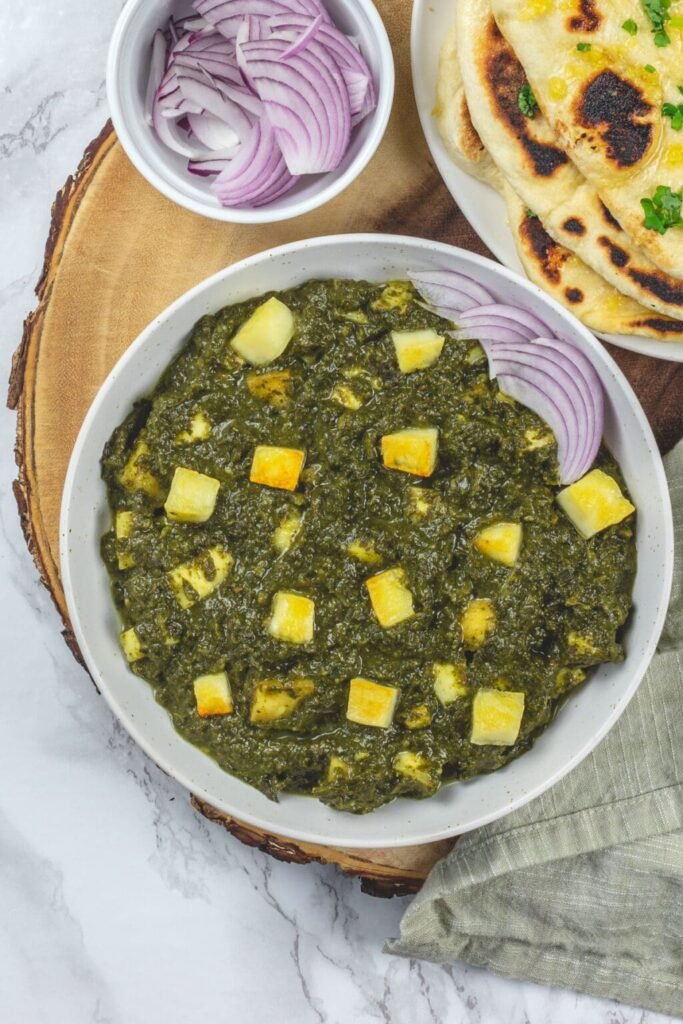
Once the greens are perfectly softened and blended to a creamy consistency, fragrant spices like cumin, ginger, garlic, and garam masala are stirred in, infusing the dish with warmth and depth. The finishing touch comes from pan-seared paneer cubes, which are crisp on the outside and delightfully soft on the inside, absorbing the rich flavors of the saag.
Instant Pot Saag Paneer with naan, paratha, or rice, plus laccha pyaaz and pickle—perfect for a hearty, flavorful Indian meal.
About This Saag Paneer Recipe
In Indian cuisine, people use the term “saag” to describe a variety of cooked leafy greens. It’s not limited to just one plant—saag can be made from a diverse mix of green leaves, depending on regional availability and personal preference.
In traditional North Indian and Punjabi cooking, a typical saag preparation often includes a hearty blend of mustard greens (sarson), spinach (palak), fenugreek leaves (methi), bathua (chenopodium), and even tender mooli (radish) leaves. These greens, when simmered together with a medley of spices, create a rich, earthy, and deeply nourishing gravy that’s full of flavor and cultural heritage.
People enjoy the iconic Sarson ka Saag in winter, typically serving it with Makki ki Roti, homemade butter, and jaggery. It’s a dish that brings warmth and nostalgia, especially for those familiar with rural Punjabi traditions.
However, it’s not always easy to find some of these traditional greens like bathua or fresh mustard leaves. Using spinach, collard greens, and kale makes this recipe accessible while preserving the authentic saag’s traditional taste and texture perfectly.
This leafy greens blend creates rich saag paired with crispy paneer, delivering a wholesome, flavorful dish perfect for any season.
Ingredient Notes
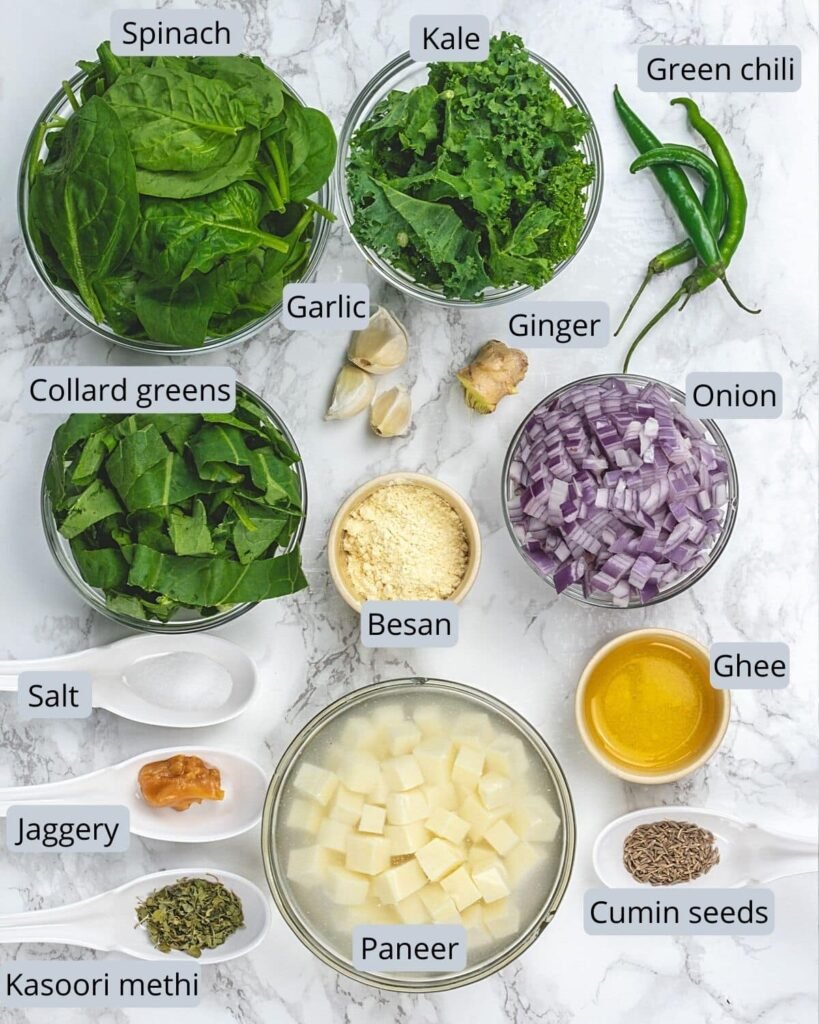
- Leafy Greens: For this saag paneer, I’ve used a flavorful and nutritious mix of spinach, kale, and collard greens.
- This trio creates a well-balanced taste and smooth texture. Feel free to try fenugreek (sparingly), broccoli rabe, beet greens, Swiss chard, or arugula to customize your saag’s flavor. Each combination will bring a slightly different flavor. For ideal proportions, check out the “Expert Tips” section below.
- Green Chilies: Green chilies are the main contributors to the heat in this dish. You can increase or decrease the quantity based on your desired spice level. For mild heat, use just one; for an extra kick, go for two or more.
- Onion, Ginger & Garlic: These three form the aromatic foundation of the saag. They build depth and complexity in the gravy, so don’t skip any of them. Freshly grated or minced versions work best for maximum flavor.
- Ghee: Traditional Indian cooking relies on ghee not just for richness but also for its deep, nutty aroma. It enhances the overall flavor of the dish and makes the saag paneer truly indulgent.
- Besan (Gram Flour): We add a spoonful of besan to thicken the saag gravy and prevent water from separating after cooking. It also gives a subtle creamy texture without the need for dairy cream.
- Jaggery: A little jaggery softens the bitterness of kale and collards; brown sugar works well as an alternative sweetener.
- Paneer: Use either homemade or store-bought paneer. To make it soft and juicy, soak the cubes in warm water for 20–30 minutes before adding them to the saag.
How To Make Saag Paneer:
1) Begin by switching on the Instant Pot and selecting the ‘Sauté’ mode. Add 2 tablespoons of ghee and allow it to melt completely. Once hot, add cumin seeds. Allow them to crackle and pop briefly, releasing their rich, nutty scent and infusing the ghee with flavor, forming a flavorful foundation for the dish.
2) Add finely chopped onions to the pot and sprinkle a pinch of salt over them. This small amount of salt accelerates the cooking process by drawing moisture from the onions, allowing them to soften more quickly and evenly.
3) Now, stir in the grated ginger, minced garlic, and chopped green chilies. As they sauté in the hot ghee, their natural oils release, enhancing the richness and warmth of the saag base and forming the flavor backbone of the dish.
4) Continue cooking this mixture for 4–5 minutes, stirring frequently. You’ll know it’s ready when the onions turn translucent with a light pink hue and the raw smell of garlic and ginger disappears.
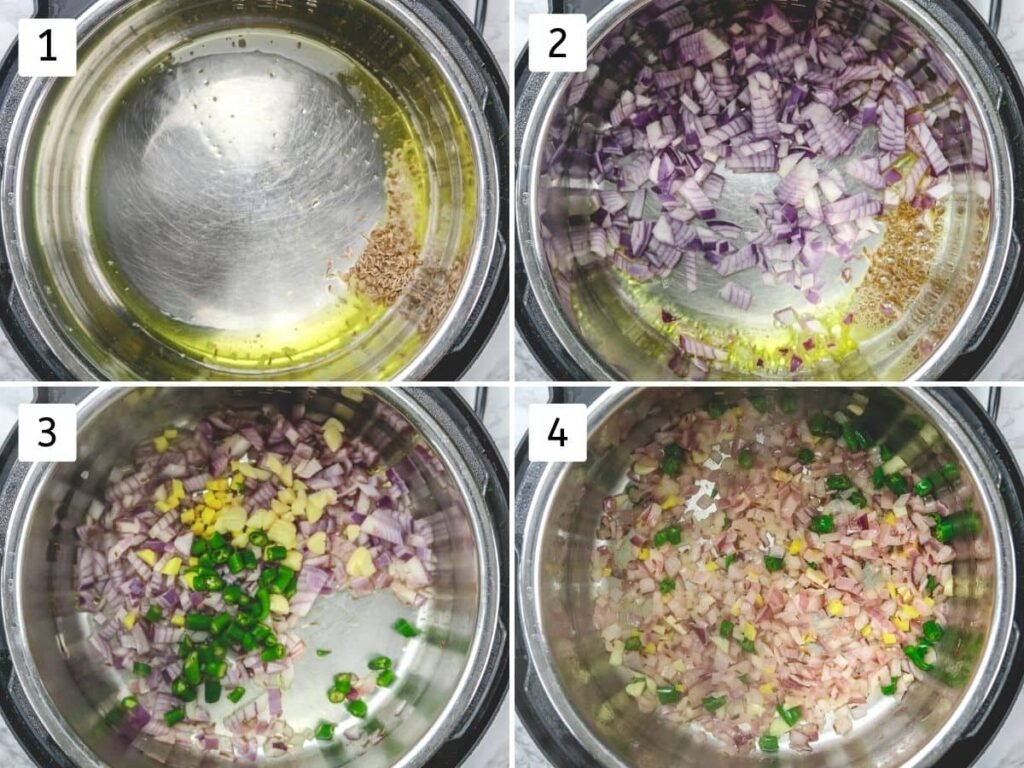
5) Add the chopped spinach to the pot. It may look like a large quantity at first, but the spinach will wilt quickly once heated. Gently stir to coat it in the aromatic mixture so it begins to release its natural water content.
6) Next, add the collard greens. These are slightly tougher than spinach, but they contribute a hearty texture and earthy flavor that balances the other greens. Fold them into the mixture slowly.
7) Incorporate the kale last among the greens. Its robust, mildly peppery flavor and firm texture add depth and substance to the saag. Stir all the greens together just until combined.
8) Add remaining salt, jaggery (or brown sugar), and ½ cup water; jaggery balances bitterness, and water aids in steam for pressure cooking.

9) Secure the Instant Pot lid, set the valve to the ‘Sealing’ position, and cook on ‘Manual’ or ‘Pressure Cook’ mode for 5 minutes. After the timer goes off, allow the pressure to release naturally (NPR). Open the lid only when the pressure pin drops down.
10) Dust the cooked greens with gram flour (besan) and crushed kasoori methi, allowing them to blend in while the mixture is still hot. The besan will help thicken the gravy while kasoori methi adds a subtle, smoky herbal note.
11) Use a hand blender to pulse the cooked greens into a thick, coarse purée. Avoid blending too long if you want to retain the rustic, grainy texture typical of traditional saag. This also keeps the mouthfeel hearty and satisfying.
12) If you prefer a creamier consistency, keep blending until the texture is as smooth as you like. While some may enjoy a velvety finish, traditional saag is intentionally left a bit rough for a more authentic experience.

13)In another pan, warm the remaining 2 tablespoons of ghee over medium heat. Once the ghee is adequately heated, carefully place the paneer cubes into the pan. Avoid crowding the pan to ensure each piece browns evenly and develops a good sear.
14) Fry the paneer cubes until they develop a light golden crust on most sides. This step not only gives the paneer a richer taste and pleasant texture but also prevents it from breaking apart when mixed with the saag.
15) Transfer the pan-fried golden paneer cubes into the saag gravy, along with any remaining ghee to enhance the richness. This enhances the richness of the dish and ensures no flavor goes to waste.
16) Gently mix the gravy to evenly coat the paneer pieces. If necessary, let the dish simmer for a few more minutes to ensure it’s thoroughly heated. Serve the saag paneer hot with soft naan, flaky paratha, or a bowl of plain steamed basmati rice for a comforting and nutritious Indian meal.
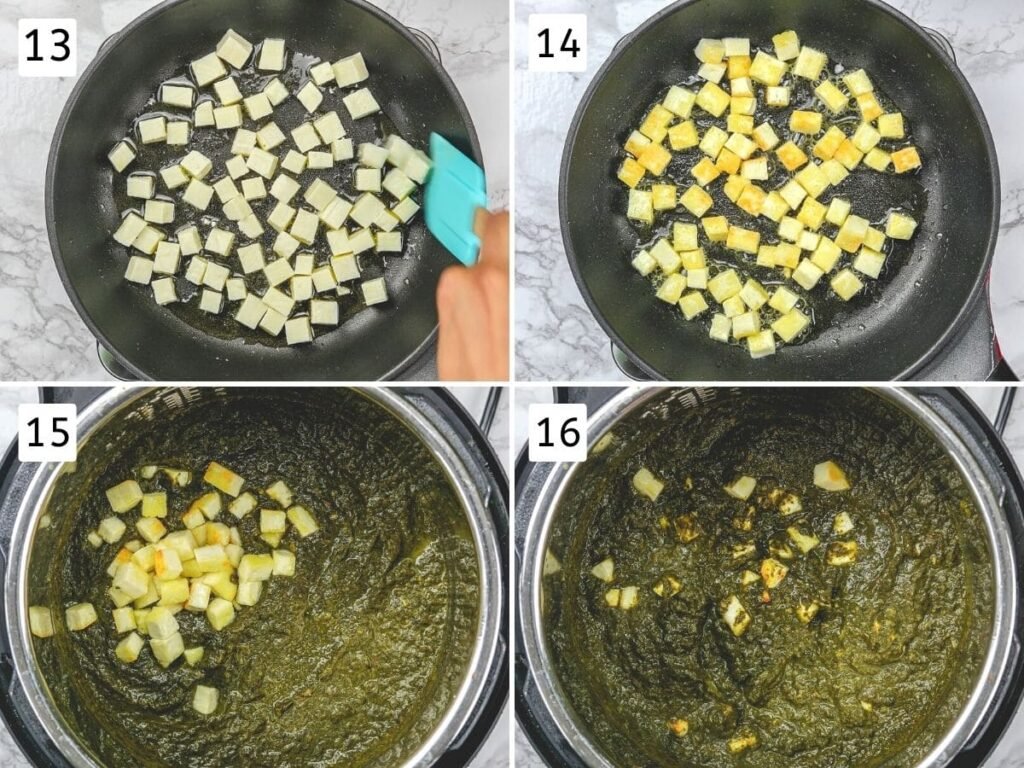
Expert Tips For Saag Paneer Recipe
- Avoid over-frying the paneer cubes, as excessive frying can cause them to develop a tough, chewy, and rubbery texture. Ideally, the paneer should be cooked until it attains a delicate, light golden hue, which indicates perfect doneness.
- If the paneer turns crisp, dark brown, or overly browned, it is a sign of overcooking, resulting in an undesirable texture.
- After incorporating the fried paneer cubes into the saag gravy, refrain from simmering or boiling the dish for an extended period.
- If reheating is necessary, warm the saag paneer gently, allowing it to reach only a gentle single boil. Excessive simmering or boiling at this stage can cause the paneer cubes to become chewy and rubbery, while also diminishing the fresh, vibrant flavors of the saag gravy.
- Traditionally coarse, saag’s texture keeps the greens’ bite, but you can blend it smooth for a creamier, equally delicious gravy.
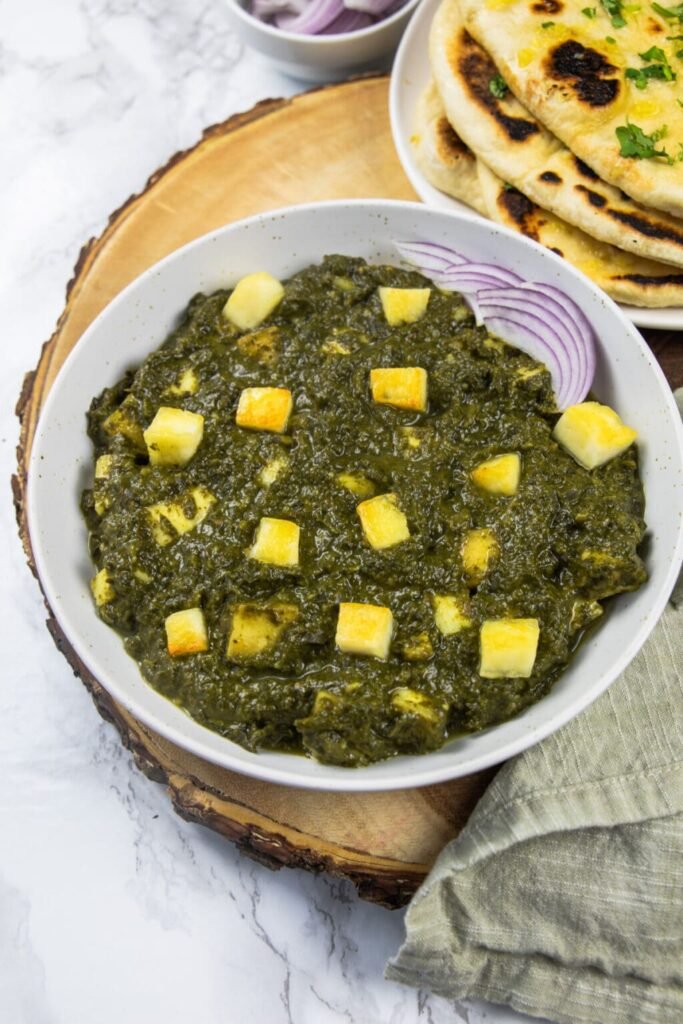
What To Serve With Saag Paneer?
- For a wholesome and satisfying meal, serve the saag paneer alongside lachha paratha or garlic naan. These Indian breads perfectly complement the creamy, flavorful saag, allowing you to scoop up every bit of the delicious gravy.
- Serve with thinly sliced onions and lemon wedges (laccha pyaaz) for a tangy, refreshing contrast to rich saag paneer.
- Alternatively, saag paneer goes excellently with aromatic jeera rice, where cumin seeds gently flavor the basmati rice, adding a subtle fragrance that elevates the entire meal.
- If you prefer a more understated option, serve the dish with plain steamed basmati rice. Its light texture and delicate flavor allow the saag paneer to shine as the star of the meal.
- These combinations create a balanced and hearty plate that satisfies both the palate and appetite, making saag paneer a perfect choice for lunch or dinner.
